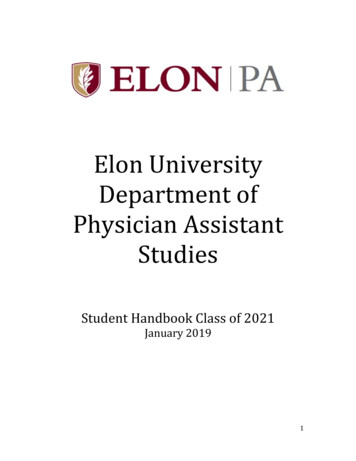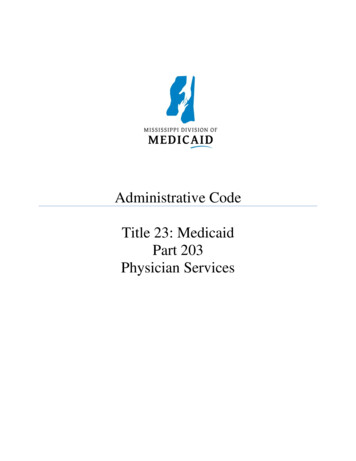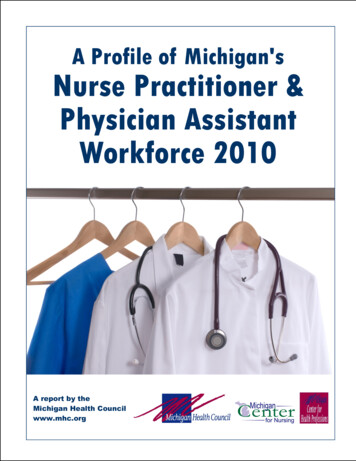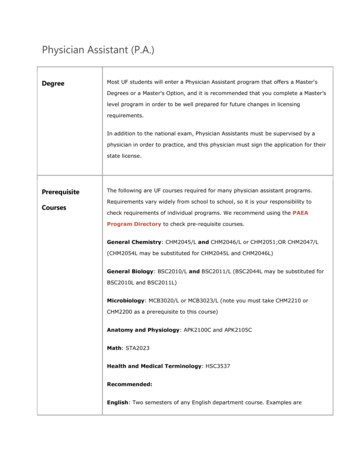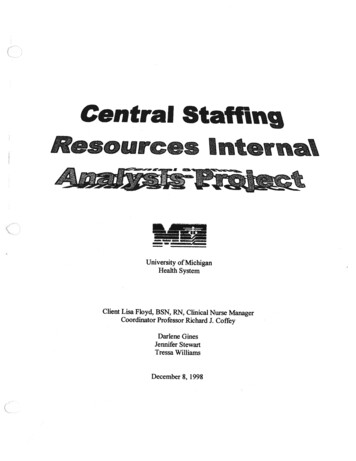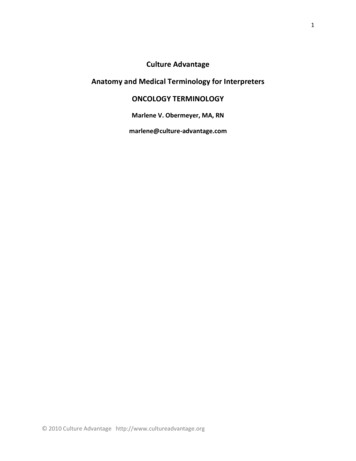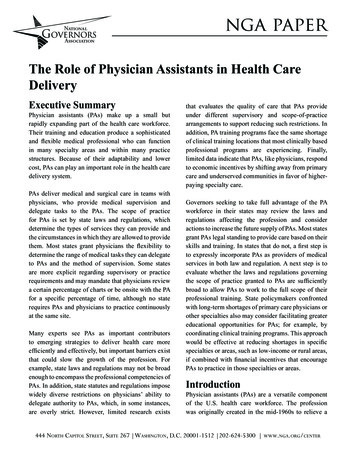
Transcription
nga paperThe Role of Physician Assistants in Health CareDeliveryExecutive SummaryPhysician assistants (PAs) make up a small butrapidly expanding part of the health care workforce.Their training and education produce a sophisticatedand flexible medical professional who can functionin many specialty areas and within many practicestructures. Because of their adaptability and lowercost, PAs can play an important role in the health caredelivery system.PAs deliver medical and surgical care in teams withphysicians, who provide medical supervision anddelegate tasks to the PAs. The scope of practicefor PAs is set by state laws and regulations, whichdetermine the types of services they can provide andthe circumstances in which they are allowed to providethem. Most states grant physicians the flexibility todetermine the range of medical tasks they can delegateto PAs and the method of supervision. Some statesare more explicit regarding supervisory or practicerequirements and may mandate that physicians reviewa certain percentage of charts or be onsite with the PAfor a specific percentage of time, although no staterequires PAs and physicians to practice continuouslyat the same site.Many experts see PAs as important contributorsto emerging strategies to deliver health care moreefficiently and effectively, but important barriers existthat could slow the growth of the profession. Forexample, state laws and regulations may not be broadenough to encompass the professional competencies ofPAs. In addition, state statutes and regulations imposewidely diverse restrictions on physicians’ ability todelegate authority to PAs, which, in some instances,are overly strict. However, limited research existsthat evaluates the quality of care that PAs provideunder different supervisory and scope-of-practicearrangements to support reducing such restrictions. Inaddition, PA training programs face the same shortageof clinical training locations that most clinically basedprofessional programs are experiencing. Finally,limited data indicate that PAs, like physicians, respondto economic incentives by shifting away from primarycare and underserved communities in favor of higherpaying specialty care.Governors seeking to take full advantage of the PAworkforce in their states may review the laws andregulations affecting the profession and consideractions to increase the future supply of PAs. Most statesgrant PAs legal standing to provide care based on theirskills and training. In states that do not, a first step isto expressly incorporate PAs as providers of medicalservices in both law and regulation. A next step is toevaluate whether the laws and regulations governingthe scope of practice granted to PAs are sufficientlybroad to allow PAs to work to the full scope of theirprofessional training. State policymakers confrontedwith long-term shortages of primary care physicians orother specialties also may consider facilitating greatereducational opportunities for PAs; for example, bycoordinating clinical training programs. This approachwould be effective at reducing shortages in specificspecialties or areas, such as low-income or rural areas,if combined with financial incentives that encouragePAs to practice in those specialties or areas.IntroductionPhysician assistants (PAs) are a versatile componentof the U.S. health care workforce. The professionwas originally created in the mid-1960s to relieve a444 North Capitol Street, Suite 267 Washington, D.C. 20001-1512 202-624-5300 www.nga.org/center
National Governors Associationshortage of primary care physicians. Military veteransof that era who had served as corpsman and medicswere trained to provide medical care under physicianoversight.1 Between 1991 and 2010, the number ofpracticing PAs almost quadrupled, growing fromabout 20,000 to about 75,000.2 Currently, more than95,000 certified PAs practice in the United States.3concludes with specific policy considerations for stateleaders who are interested in getting the greatest valuefrom their PA workforce.Today, PAs play a broad and expanding role inthe health care system, working in a variety ofpractice areas and settings. At the practice level,PAs provide care for a much lower cost of laborthan physicians. PAs working in family medicinereceive about half the salary of physicians, andthose working in specialties make about one-third asmuch as physicians in the same specialty.4 Becauseof their flexibility and lower costs, PAs are oftenan important component of strategies to alleviateprovider shortages and increase the efficiency of thehealth care delivery system.5PAs are integrated into the health care deliverysystem in most settings and specialties. They make up10 percent of the primary care workforce and represent9 percent of clinicians in community health centers.6They also play a special role in federally designatedrural health clinics, which are required to have a PA, anurse practitioner, or certified nurse midwife availableduring at least 50 percent of their operating hours.7 Inspecialty care, PAs make up a significant percentageof staff practicing in rural hospitals.8 In addition,most PAs work in a variety of specialties, includingoncology, dermatology, gastroenterology, orthopedics,and behavioral health.9 Nearly 50 percent of PAsreport having worked in two to three areas of medicineover their careers, a fact that further underscores theiradaptability.10This issue brief describes the role of PAs in the U.S.health care system and barriers that may preventPAs from being used to maximum effect. The briefCurrent Role in DeliveringHealth CareCurrent Areas of PracticeRandy Danielson, Ruth Ballweg, Linda Vorvick, and Donald Sefcik, The Preceptor’s Handbook for Supervising Physician Assistants (Sudbury,MA: Jones & Bartlett Learning, 2012).2Perri A. Morgan, Nilay D. Shah, Jay S. Kaufman, and Mark A. Albanese, “Impact of Physician Assistant Care on Office Visit Resource Use in theUnited States,” Health Services Research 43 no. 5 part 2 (October 2008): 1906–1922; and Roderick S. Hooker, James F. Cawley, and Christine M.Everett, “Predictive Modeling the Physician Assistant Supply: 2010–2025,” Public Health Reports 126 no. 5 (2011): 708–716.3National Commission on Certification of Physician Assistants, “For the Public,” http://www.nccpa.net/Public (accessed April 15, 2014).4Medscape, Physician Compensation Report 2013, 1296/ (accessed April 16, 2014); and The Clinical Advisor, “2013 Nurse Practitioner & Physician Assistant Salary Survey,” 1296/%20 (accessed September 19, 2014).5Roderick S. Hooker, James F. Cawley, and William Leinweber, “Physician Assistant Career Mobility and the Potential for More Primary Care,”Health Affairs 29 no. 5 (2010): 880–886.6Agency for Healthcare Research and Quality, “Primary Care Workforce Facts and Stats No. 3,” rimary/pcwork3/index.html (accessed September 19, 2014).7U.S. Department of Health and Human Services, “Rural Health Clinic,” Rural Health Fact Sheet Series (January 2013), lthClinfctsht.pdf (accessed August 25, 2014).8Roderick S. Hooker, David J. Klocko, and G. Luke Larkin, “Physician Assistants in Emergency Medicine: The Impact of Their Role,” AcademicEmergency Medicine 18 no. 1 (January 2011): 72–77; Doan Quynh, Vikram Sabbhaney, Niranjan Kisson, Sam Sheps, and Joel Singer, “A SystematicReview: The Role and Impact of the Physician Assistant in the Emergency Department,” Emergency Medicine Australasia 23 (2011): 7–15; and LisaR. Henry, Roderick S. Hooker, and Kathryn L. Yates, “The Role of Physician Assistants in Rural Health Care: A Systematic Review of the Literature,” Journal of Rural Health 27 (2011): 220–229.9Anita Duhl Glicken and Anthony A. Miller, “Physician Assistants: From Pipeline to Practice,” Academic Medicine 88, no. 12 (December 2013); andCatherine Dower and Sharon Christian, “Physician Assistants and Nurse Practitioners in Specialty Care: Six Practices Make It Work,” prepared forthe California Health Foundation (June 2009), re-six-practices-make-it-work (accessed October 9, 2013).10Glicken and Miller, “Physician Assistants: From Pipeline to Practice.”1Page 2
National Governors AssociationRole of Delegation and SupervisionPAs perform a wide range of duties, includingproviding routine care, treating acute and chronicillnesses, managing hospital inpatients, performingminor surgeries, and assisting during major surgeries.11To a large degree, supervising physicians are grantedthe flexibility to delegate tasks to PAs and determineappropriate supervision methods, but state scope-ofpractice laws sometimes limit physicians’ authority.For example, although all states allow PAs to prescribemedication, 14 place some limitations on the typesof medications PAs can prescribe.12 Eleven statesalso stipulate a specific list of tasks physicians areallowed to delegate to PAs. To delegate beyond thosetasks, a physician must get approval from the statemedical board. The American Academy of PhysicianAssistants (AAPA) argues that such restrictionsimpede physicians’ flexibility to manage theirworkload and that physicians should have the authorityto delegate such tasks at the local level. (See Table 1for a summary of state restrictions on delegation andthe Appendix B for state-by-state information aboutdelegation restrictions that the AAPA tracks.)13Typically, PAs work directly with physicians atthe same site. A small number of PAs (3.4 percent)report that their supervising physician is offsite.14All states have laws and regulations that explicitlyauthorize physicians to supervise PAs throughelectronic communication, but some states couple thatauthorization with requirements for in-person contact.Twenty-five states place restrictions on how often thephysician supervisor must be onsite (for example,site visits may be required once a month or every twoweeks), require supervising physicians to be withina certain travel time or distance, or require that thestate medical board approve the physician’s plans (seeTable 2). In some of those states, those requirementsare tiered and reduced as a PA gains more experience.Twenty-four states require a physician’s signatureon some percentage of the charts of patients whomPAs treat. Most states specify how many PAs onephysician can supervise—usually between two andsix. (See Appendix B for state-by-state informationabout supervision requirements for PAs.)Table 1. Restrictions on Delegation toPAsDelegation RestrictionsNumber of StatesSome prescribing limits14Legislation or board sets tasklimits11Source: American Academy of Physician AssistantsPA practice is diverse, and supervision requirementscan be implemented in many different ways, evenunder the same state law or regulation. Under Coloradoregulations, for example, a “supervising physician musteither be onsite with the PA or be readily available bytelecommunication.”15 Examples from several practicesin Colorado illustrate how varied supervision can beunder these requirements. At one suburban practice,the supervising physician delegates examinations,diagnoses, and treatment decisions to two PAs.16 Thesupervising physician is off site but provides medicaldirection and periodically reviews charts that the PAscomplete.17 Another practice, located in rural Colorado,allows PAs to see patients, make diagnoses, and providetreatment, but a physician is onsite and available forconsultations, as needed.18 A third practice in an urbanDower and Christian, “Physician Assistants and Nurse Practitioners in Specialty Care.”In most of these cases, state law restricts PAs from prescribing Schedule II medications, which are designated under federal law as having a highpotential for abuse, with the possibility of psychological or physical dependence.13American Academy of Physician Assistants, “Supervision of Physician Assistants: Access and Excellence in Patient Care” (October 2011), http://www.aapa.org/workarea/downloadasset.aspx?id 635 (accessed August 25, 2014).14Glicken and Miller, “Physician Assistants: From Pipeline to Practice.”15American Academy of Physician Assistants, Physician Assistants: State Laws and Regulations, 13th Edition (January 2013), http://www.aapa.org/workarea/downloadasset.aspx?id 491 (accessed August 25, 2014).16Colorado Health Institute, Collaborative Models of Primary Care: Case Studies in Colorado Innovation (October 2010), nloads/CollaborativePrimaryCare.pdf (accessed December 6, 2013).17Ibid.18Ibid.1112Page 3
National Governors Associationarea allows PAs to examine patients, but physiciansmake all final treatment decisions.19 All of thosepractices are in the same state and held to the samestatutory and regulatory standards, but they havedeveloped different methods for using PAs based ontheir patients’ needs and the PAs’ abilities.Table 2. Supervision RequirementsImposed by State Legislation orMedical BoardsSupervision RequirementsNumber ofStatesTravel time or distance limits25Chart co-signatures required24Supervision ratio40** Includes the District of ColumbiaSource: American Academy of Physician AssistantsPAs and New Models of CareBecause of the flexibility, adaptability, and costeffectiveness of PAs, the profession can play acritical role in delivery system transformation and,in particular, the provision of more integrated, teambased care. Physician associations have joined theAAPA in affirming that physicians and PAs workingin team-oriented practices are a proven model fordelivering high-quality, cost-effective patient care.20To encourage the success of team-based models ofcare, the associations also support the interprofessionaleducation and family medicine rotations of medicalstudents, family medicine residents, and PA students.The associations promote flexibility in state regulationsto allow individual practices to determine appropriateroles and supervision levels for PAs.21In particular, PAs can play an important role in patientcentered medical homes (PCMHs), which are designedto coordinate and integrate care across settings.22 Forexample, in a PCMH practice in New York, patientscan select a PA as their primary care provider.23 Inthat practice, the PA sees walk-in acute-care patientsas well as the patients who have been assigned tohim or her on a long-term basis. In another advancedmedical home in rural New York, a PA serves as themain provider of care for all patients, with supportfrom a remote physician.24 In Connecticut, a PCMHinitiative provides enhanced payments for medicalhome services to providers who include physiciansand PAs.25Current Capabilities: Education andLicensureStates play an important role in the education, training, and licensure of PAs. The average educationalprogram for PAs lasts 27 months (three academicyears) at the graduate level.26 By 2021, in recognitionof the high level of academic achievement required ofPAs, all students who graduate from an accredited PAprogram will be awarded a master’s degree.27 In 2005,67 percent of programs provided master’s degrees, aIbid.American Academy of Physicians Assistants, Physician Assistants and the Patient-Centered Medical Home (June 2011), http://www.aapa.org/workarea/downloadasset.aspx?id 581 (accessed November 18, 2013). See also American Academy of Physician Assistants and American College ofPhysicians, Internists and Physician Assistants: Team-Based Primary Care (2010), http://www.acponline.org/advocacy/current policy papers/assets/internists asst.pdf; and American Osteopathic Association and American Academy of Physician Assistants, Osteopathic Physicians and Physician Assistants: Excellence in Team-based Medicine (July 2013), http://www.aapa.org/workarea/downloadasset.aspx?id 1700 (accessed August 25, 2014).21Ibid.22Albert Wu, “Compared to Usual Care, What Is the Effect of Care from a Non-Physician Patient-centered Medical Home on Care Quality and PCOs?” Research Prioritization Topic Brief (April 2013), care-Systems-TopicBrief-09-041613.pdf (accessed September 19, 2014).23American Academy of Physician Assistants, Physician Assistants and the Patient-Centered Medical Home.24Ibid.25Patient-Centered Primary Care Collaborative, “Husky Health Person-Centered Medical Home Program Initiative,” n-centered-medical-home-program-initiative (accessed August 25, 2014).26American Academy of Physician Assistants, “What Is a PA?” http://www.aapa.org/the pa profession/what is a pa.aspx (accessed November 19,2013).27Accreditation Review Commission on Education for the Physician Assistant, “ARC-PA Standards Degree Deadline Issue,” 011fnl.pdf (accessed August 25, 2014).1920Page 4
National Governors Associationsubstantial increase from 1995, when only 16 percentof programs did so.31PAs as Owners andEmployersAccreditation standards require PA programs toprovide a generalist education rather than focus on anyparticular specialty.32 During their program, studentscomplete clinical rotations in emergency medicine,family medicine, internal medicine, pediatrics, surgery,behavioral medicine, and obstetrics and gynecology.Graduates from an accredited PA program are eligibleto sit for a national exam that the National Commissionon Certification of PAs (NCCPA) offers.33 All statesrequire that prospective PAs pass that exam to receivea license to practice.34 In addition, PAs must complete100 hours of continuing medical education every twoyears.35 They also must pass a recertification examevery 6 years, although the profession is moving froma 6-year recertification cycle to a 10-year cycle.36Medical supervision and employment of PAsare separate activities and treated separatelyunder some state laws. Although it is rare,some PAs actually own their own practicesin part or completely, and some employphysicians.28 States determine whetherthat is allowed. Arizona, Maryland, NorthCarolina, and Washington are among statesthat allow PAs to own their own practices.29For example, a rural health clinic in NorthCarolina is owned by a PA, who is the soleprovider of care. The physician supervisorowns shares in the clinic and supervises bytelephone. In an example from Washington, aPA owns an urgent care clinic and employs aphysician, who provides on-site supervision.In a third example from Arizona, two PAsopened their own primary care clinic in 2004,which at the time was the only primary careclinic in downtown Tucson.30 They hireda physician as an independent contractorto provide supervision and met weekly inperson. In each case, the physician providedmedical supervision, regardless of his or herstatus as an employee.Postgraduate clinical training programs are not requiredfor licensure or for PAs to practice in a specialty area,and a recent estimate found that fewer than 2 percentof PAs pursue such training.37 The NCCPA hascreated optional Certificates of Added Qualificationsfor postgraduate training in cardiovascular thoracicsurgery, emergency medicine, nephrology, orthopedicsurgery, and psychiatry. The AAPA opposes requiringresidencies or postgraduate certifications for entryinto clinical specialties and expresses concern thatformally accrediting such programs could lead tothe profession losing its generalist focus, even if theprograms remain voluntary.38 One survey found thatPAs who chose postgraduate clinical training didso because they felt it provided more employmentAmerican Academy of Physician Assistants, Physician Assistants and Practice Ownership (March 2011), d 631 (accessed August 25, 2014).29Stephen Cornell, “PA Owned and Operated,” x (accessed August 25, 2014).30LewEllyn Hallet, “Caring for Those on the Fringe,” St. Paul’s School Alumni Horae 89 no. 2, p. 18 (2009), https://www.sps.edu/ftpimages/36/misc/misc 53097.pdf (accessed September 19, 2014).31Virginia H. Joslin, Patricia A. Cook, Ruth Ballweg, et al., “Value Added: Graduate-Level Education in Physician Assistant Programs,” The Journal of Physician Assistant Education 17, no. 2 (2006): 16–30, http://www.paeaonline.org/index.php?ht a/GetDocumentAction/i/3530 (accessed August 25, 2014).32Danielson, The Preceptor’s Handbook for Supervising Physician Assistants.33National Commission on Certification of Physician Assistants, “About Us: Purpose and Mission,” http://www.nccpa.net/About (accessed September 1, 2014).34American Academy of Physician Assistants, “Statutory and Regulatory Requirements for State Licensure” (February 2013), http://www.aapa.org/workarea/downloadasset.aspx?id 599 (accessed September 1, 2014).35National Commission on Certification of Physician Assistants, “Certification Process Overview,” http://www.nccpa.net/CertificationProcess (accessed April 17, 2014).28Page 5
National Governors Associationopportunities and the possibility of a higher salary,although the actual effect on employment and salaryis unclear.39 Residency program directors have arguedthat residencies better prepare PAs than on-the-jobtraining in a specialty.40Challenges of Integrating PAsinto Health Care DeliverySystemsState policymakers struggling with health careworkforce shortages in underserved communities,including many rural areas, might consider the potentialbenefits and costs of expanding the integration of PAsinto the evolving health care delivery system. To do so,states can examine existing regulations, the availabilityof training programs, and incentives to guide PAs toneeded practice areas.Statutory and Regulatory ConsiderationsState statutory and regulatory frameworks related toPAs can serve as a barrier to maximizing the workforce.In some instances, outdated regulatory language thatwas crafted before PAs became widespread might notinclude the profession in the definition of providers.States seeking to enable PAs to practice to the fullextent of their abilities could review their currentstatutes and regulations to ensure that the definitionof provider under the law and in regulations is broadenough to encompass the professional competenciesof PAs. Several states have revised their laws andregulations to address this problem. For example,Massachusetts law officially designates PAs asprimary care providers.41 Minnesota law uses theterm personal clinician and includes PAs in the term’sdefinition.42 Vermont law uses the term health careprofessional and includes PAs in that definition.43Some states explicitly include PAs in the statutoryauthorization for their medical home programs,including Iowa, Maine, and Vermont.44Another challenge is that the appropriate level ofsupervision and scope of practice that take fulladvantage of PAs’ training and capabilities remainuncertain. Some experts believe that decisions aboutthe manner in which PAs are supervised should bemade at the practice level and that dictating the precisenature of a physician’s supervisory role in state lawmay lead to inefficiencies without increasing patientsafety.45 Some research suggests that PAs providean equivalent quality of care to other providers (onsimilar tasks). One study found that PAs have alower rate of malpractice than do physicians.46 Littleresearch, however, compares the quality of care thatPAs provide under different supervision and scope-of-This change in recertification cycles is posited on making the recertification process more efficient and aligned with other medical professions.Christopher Doscher, “A Primer on the 10-Year Recertification Cycle,” Advance Healthcare Network for NPs & PAs (April 18, 2012), le.aspx (accessed April 16, 2014).37Maura Polansky, Gloria J. Hsieh Garver, Laurie N. Wilson, Mary Pugh, and Ginny Hilton, “Postgraduate Clinical Education of Physician Assistants,” The Journal of Physician Assistant Education 23, no. 1 (2012).38American Academy of Physician Assistants, Maintaining Professional Flexibility: Issues Related to Accreditation of Postgraduate Physician Assistant Programs, http://www.aapa.org/workarea/downloadasset.aspx?id 790 (accessed November 21, 2013).39Michael Anick, Jim Carlson, and Patrick Knott, “Postgraduate PA Residency Training,” Advance Healthcare Network for NPs & PAs 11, no. 1(February 1, 2003), -Training.aspx (accessedAugust 25, 2014).40Ibid.41An Act Improving the Quality of Health Care Costs Through Increased Transparency, Efficiency, and Innovation, The 188th General Court of theCommonwealth of Massachusetts, ch. 224, sec. 72, 12/Chapter224 (accessed August 25, 2014).42American Academy of Physician Assistants, Physician Assistants and the Patient-Centered Medical Home.43Ibid.44Ibid.; American Osteopathic Association and American Academy of Physician Assistants, Osteopathic Physicians and Physician Assistants.45Ibid.46Planning Unit Health System Planning, Research & Analysis Branch, Health System Strategy & Policy Division, Ontario Ministry of Health andLong-Term Care, A Literature Review on Physician Assistants (August 2011), ureReview PhysicianAssistants.pdf (accessed August 25, 2014); and Roderick Hooker, Jeffrey Nicholson, and Tuan Le, “Does the Employment of Physician Assistantsand Nurse Practitioners Increase Liability,” Journal of Medical Licensure and Discipline 95, no. 2 (2009): 6–16.36Page 6
National Governors Associationpractice requirements, and states might want to lookfor further evidence on quality of care as they considerthe most appropriate requirements for PAs.47As policymakers consider PA supervisory requirements,they can compare their own laws and regulations withthose in other states and ensure that theirs are in linewith PAs’ current education and training. For example,states could choose to consider whether regulationssuch as those that require physicians supervising PAs tosign a certain number of charts or be onsite for specificamounts of time are necessary to ensure quality careand protect patients. A simple correlation indicates thatstates with the most restrictive supervision requirementsalso tend to have the lowest ratio of PAs to physicians.48Some states have chosen to remove certain restrictionsafter reviewing their laws and regulations in light ofthose of other states. For example, Washington recentlyremoved a requirement that physicians be onsite forat least 10 percent of the time a PA is practicing.49Indiana recently allowed PAs to prescribe Schedule IImedication.50 In 2013, Missouri changed a law that hadrequired physicians to be onsite with PAs a majorityof the time to allow on-site supervision for half a dayevery two weeks.51However, the effects on access to care of changing scopeof-practice regulations remain unclear. Further researchthat compares the quality of care that PAs provide undervarying practice models could better inform policymakersas they consider the most appropriate requirements forPAs.52 Government funding for research into scope ofpractice for PAs would provide an objective source ofinformation on a topic where the most common fundingsources tend to be interested parties. Policymakers coulduse more research that directly answers questions ofimportance to the states, such as the studies that havebeen funded by agencies like the Health Resources andServices Administration (HRSA) in the U.S. Departmentof Health and Human Services for nurse practitioners.53States also might consider providing support for suchresearch as they innovate. For example, in California,the Health Manpower Pilot Projects Program approvestemporary waivers of workforce regulations to allow forexperimentation.54Expanding the PA WorkforcePAs make up a small but growing part of the healthcare workforce, and governors might consider adoptingstrategies to increase their numbers.55 A first step isassessing the number of PAs graduating in their statesas well as the number of graduates who remain in thestate to practice. Although the number of PA programshas continued to increase, projections suggest thatthe number of job openings for PAs could exceed thenumber of PA graduates over the next few years.56 SomeIbid.Janet P. Sutton, Christal Ramos, and Jennifer Lucado, “US Physician Assistant (PA) Supply by State and County in 2009,” Journal of the AmericanAcademy of Physician Assistants 23 no. 9 (2010): E5–E8.49American Academy of Physician Assistants (AAPA), “Washington Patients Have Increased Access to Health Care,” AAPA Blog, entry postedAugust 1, 2013, http://www.aapa.org/twocolumn.aspx?id 1424 (accessed September 19, 2014).50Aubrey Westgate, “Several States Rethink PA Scope of Practice, AAPA Weighs In,” Physicians Practice, May 29, 2013, tes-rethink-pa-scope-of-practice-aapa-weighs-in 5998 (accessed September 3, 2014).51Michele Munz, “Not enough doctors, so Missouri law paves way for physician assistants to provide care,” St. Louis Post-Dispatch, July 14, ves-way-for-physician/article 0a0f1bd7-8051513c-a93e-5298208ea6d1.html (accessed September 3, 2014).52Ibid.53Eric Larson, “Practice Characteristics of Rural
practice laws sometimes limit physicians' authority. For example, although all states allow PAs to prescribe medication, 14 place some limitations on the types of medications PAs can prescribe.12 Eleven states also stipulate a specific list of tasks physicians are allowed to delegate to PAs. To delegate beyond those

